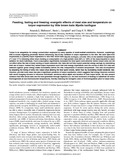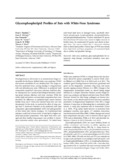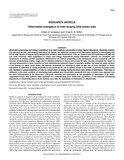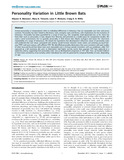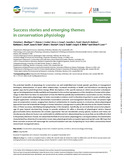Browsing Craig K. R. Willis by Title
Now showing items 8-12 of 12
-
Feasting, fasting and freezing: energetic effects of meal size and temperature on torpor expression by little brown bats Myotis lucifugus
(Company of Biologists, 2010)Torpor is an adaptation for energy conservation employed by many species of small-bodied endotherms. However, surprisingly little is known regarding proximate factors influencing day-to-day variation in torpor expression ... -
Glycerophospholipid Profiles of Bats with White-Nose Syndrome
(The University of Chicago, 2015)Pseudogymnoascus destructans is an ascomycetous fungus responsible for the disease dubbed white-nose syndrome (WNS) and massive mortalities of cave-dwelling bats. The fungus infects bat epidermal tissue, causing damage to ... -
Hibernation energetics of free-ranging little brown bats
(Company of Biologists, 2012)Hibernation physiology and energy expenditure have been relatively well studied in large captive hibernators, especially rodents, but data from smaller, free-ranging hibernators are sparse. We examined variation in the ... -
Personality Variation in Little Brown Bats
(2013-11-27)Animal personality or temperament refers to individual differences in behaviour that are repeatable over time and across contexts. Personality has been linked to life-history traits, energetic traits and fitness, with ... -
Success stories and emerging themes in conservation physiology
(Oxford University Press and the Society for Experimental Biology, 2016)The potential benefits of physiology for conservation are well established and include greater specificity of management techniques, determination of cause–effect relationships, increased sensitivity of health and disturbance ...

